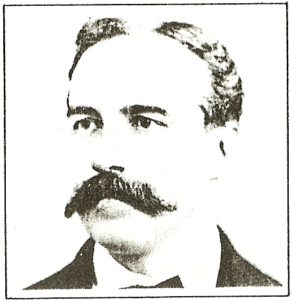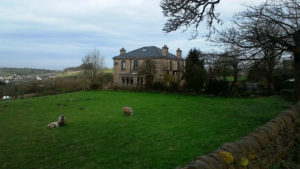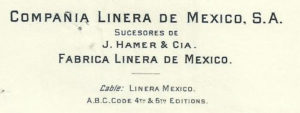Job Hamer

Job Hamer
Job Hamer was born in Lancashire in 1831. According to the registration of Job’s birth, his father, John Hamer, was a spinner. We don’t know anything about Job’s schooling, but he certainly emerged as a merchant and entrepreneur. His ‘diaries’ indicate that he was literate, resourceful, ambitious and considered himself very much a ‘gentleman’. He was a Manchester Warehouseman at the time of his wedding in 1860. A Manchester warehouseman was a wholesaler in products for which Manchester for famous, especially cloth and fabrics. The 1861 census shows his occupation as ‘Shipping warehouseman’.
There can be no doubt that Job travelled a lot for his work. According to the diaries he worked for a company referred to as ‘A&I Lt,’ and he seems travelled to the USA, Cuba and Mexico as a salesman for this company. In the early 1860s he appears to have set up a company with a partner, which was probably called ‘H&R Lt’ or ‘R&H Lt.’ This company was in direct competition with A&I Lt, and from his diaries we learn that he and his partner were developing contacts in Cuba and Mexico (and also in the USA) with a view to developing their business. One can conclude that Job was away from home a great deal, since a journey to these markets was both expensive and time consuming. The journey described in the ‘diaries’ was almost of six months’ duration (click here for an account of that journey).

Sherfin House in 2016
Job Hamer must have done quite well, at least for a time. In 1871 he and his family lived in a fairly large house at Henheads, Haslingden. The house (Sherfin House) still stands today and probably doesn’t look very different to how it did then. In the 1871 census, Job’s occupation was listed as a ‘Cotton Spinner and manufacturer employing about 60 hands and also farmer of 22 acres employing one labourer’, as well as being a West India Merchant employing 3 clerks. Job and his wife Mary (nee Moseley) had ten children in all. By 1881 things apparently changed a lot for Job and his family. After generations of living in Lancashire and Cheshire all of a sudden the family is found living in Kilmalcolm, Scotland. I remember my grandmother telling me that Job (who was her grandfather) went through a difficult spell with his business. I wish I had paid more attention. The Morning Post of 2nd Sept 1871 reports “At a meeting of the creditors of Job Hamer & Co., merchants at Baxenden and Manchester, a composition of 5s in the pound was accepted.”

Watercolour by Job Hamer, Scotland 1879
It must have been around this time that Job founded a new business in Mexico City. It was a linen mill called J. Hamer & Cia, Fabrica Linera de Mexico. It would be very interesting to know how and where he raised the investment necessary to do this. He might have sold Sherfin House as a way of raising money. My grandmother used to say that she remembered being told that every year there would be a family discussion: should the profits be used to bring another loom from England, or should they be used to bring over another one of the daughters? In the end most of Job’s children moved to Mexico, at least for a while. As far as I can tell, his wife Mary never moved to Mexico, and she died quite young, in Scotland, in 1883.
In the end most of Job’s children moved to Mexico, at least for a while. As far as I can tell, his wife Mary never moved to Mexico, and she died quite young, in Scotland, in 1883.
The ‘Linera’ seems to have done very well. It was a brilliant example of moving the factory close to the market. They sold linen in Mexico (and further afield), and I believe that they had a contract to supply the linen to make uniforms for the Mexican army under the then president, Porfirio Diaz. The main weakness of the business model was that they had to import all the flax needed for production, and the only sources of linen-grade flax at the start of the 20th century were Ireland, Russia and Belgium. Job spent many years trying to find a micro-climate within the extensive and varied geography of Mexico which could produce the flax, but to no avail. The plants could be grown, but the fibres they produced were too brittle to be of use to a linen mill.
Job was an active member of the British colony in Mexico. He was very much involved with the building of the original Christ Church in Mexico, and was one of the three major donors who paid for it. A magnificent reredos, in high Victorian anglo-catholic style, made by the London firm AC Kempe was installed at the church in 1908. The reredos was dedicated to the memory of Job, although I’m not sure whether he paid for it, and can still be seen in the new Christ Church building in Las Lomas.
Job had problems with his health, and found it difficult to cope with the dryness and altitude of Mexico City. He moved to a large house in Cuernavaca probably around the turn of the century, and he died there in 1905. His body was brought back to Mexico and was buried in the British Cemetery.
Michael Johnson, Feb 2017
Additional materials available electronically:
Travels to Mexico 1865-6
An account written by Michael Johnson based on Job’s ‘Diary’
Virginia G Young’s account of Job’s history in Mexico
Virginia Young wrote an account of several eminent members of the British colony in Mexico, published as pamphlet No 2 by the British and Commonwealth Society in Mexico, 1988. This is an excerpt containing the account of Job and it tells us something about ‘La Linera’.
Transcription of Job Hamer’s ‘diary’
Transcribed by Michael Johnson in 2016